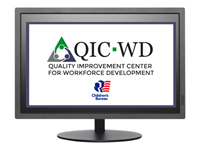Child Welfare Quality Improvement Center for Workforce Development (QIC-WD)
Date of this Version
5-2022
Document Type
Article
Abstract
Exploration of Needs
The Quality Improvement Center for Workforce Development (QIC-WD) worked with the Oklahoma Department of Human Services (DHS) to conduct a needs assessment. A variety of information was explored to learn about the current workforce and the agency’s child welfare workforce practices, including:
- recruitment, hiring, and retention metrics and processes,
- organizational culture and climate, and
- other workforce processes and initiatives, such as onboarding, mentoring, supervision, performance management, training, and employee recognition.
More specifically, four major types of information were considered: 1) objective data from various agency databases and reports; 2) subjective perceptions of staff and supervisors, gathered through surveys; 3) expertise and input of the project steering committee; and 4) QIC-WD team expertise and feedback. The goal was to identify areas of need that could be addressed through a workforce intervention that met a set of QIC-WD criteria (see below).
Identification of Priority Needs
Oklahoma’s steering committee expressed a desire to explore the hiring process for new workers at the beginning of the needs assessment process. The criteria used for employee selection varied widely across the state and there was no standardized process from office to office. The steering committee expressed a need to better understand what characteristics were associated with good performance and how to hire people with those characteristics. Keeping this interest in mind, the team conducted a thorough needs assessment process to explore and rule out any other pressing agency needs. Three areas of need were identified as opportunities for intervention:
- hiring of new workers
- promotion decisions for lead worker and supervisor positions
- staff recognition and rewards.
Intervention Selection
To determine which intervention to implement, the following QIC-WD criteria were considered: 1) alignment with agency need, 2) level of existing evidence of effectiveness, 3) applicability to other agencies’ needs and circumstances, 4) scope and magnitude, relative to agency and QIC-WD capacity, 5) evaluation potential, 6) contribution to a diverse array of interventions across QIC-WD sites, and 7) acceptability to both the agency and the QIC-WD. The team engaged in a root cause analysis discussion and decided to focus on the hiring process for Child Welfare Specialist position. A selection intervention addressed a key need for Oklahoma and satisfied the goals and objectives of the QIC-WD. Further, hiring of child welfare staff hasn’t received much attention in the academic literature and is very applicable to other agencies’ needs, making it a good candidate for a QIC-WD project.
Included in
Industrial and Organizational Psychology Commons, Performance Management Commons, Public Policy Commons, Social Welfare Commons, Social Work Commons, Training and Development Commons


